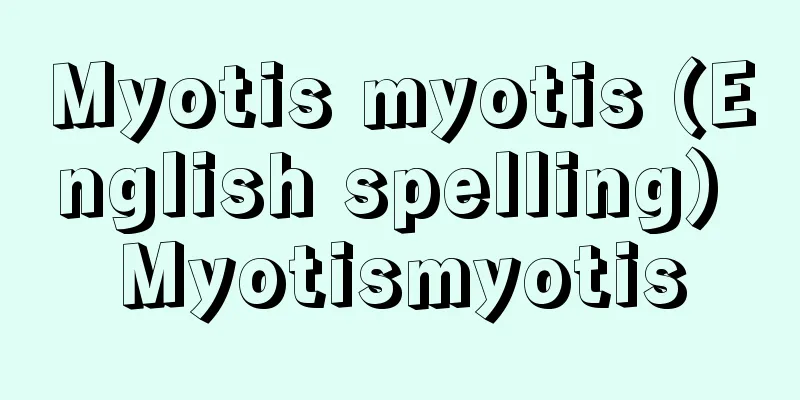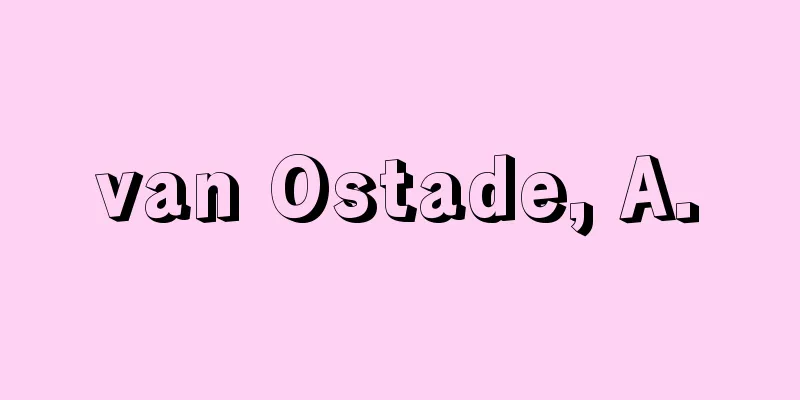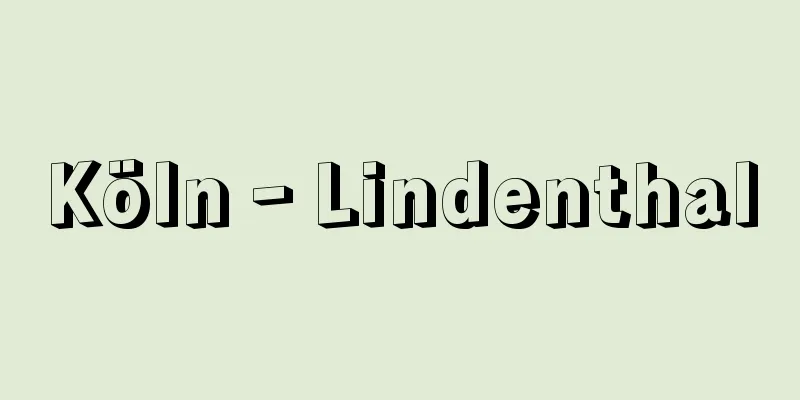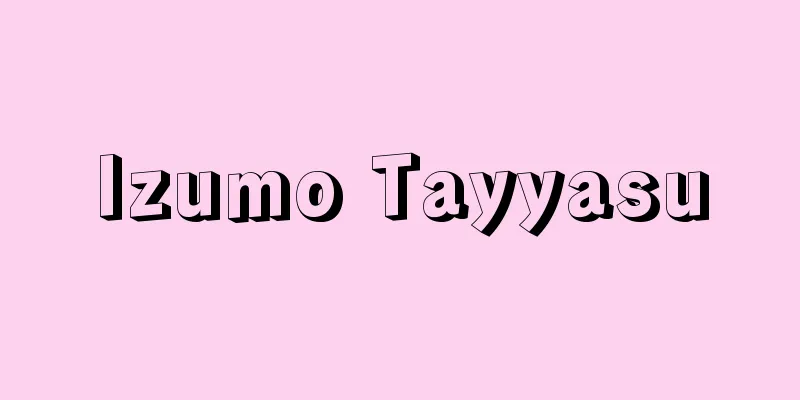Annual tax - Nengu

|
A tax that was imposed from the Middle Ages to the early modern period. Nogu, kanmotsu, shoto, and mononari are sometimes used as synonyms. [Kenji Iinuma] Taxes under the manor systemUnder the Ritsuryo system, there were taxes such as so (rent), yo (tax), cho (tax), and zoyo (tax on miscellaneous duties), but in the mid-Heian period, as the Ritsuryo system was disintegrating, two new types of taxes appeared: official taxes on rice fields and temporary miscellaneous duties. It is believed that the former type of tax was established as the manor system was established from the mid-11th century onwards. The word nenku first appeared in documents at the end of the 11th century, and in the 12th century, it was written in hiragana as "nenku," and in the oldest commentary on the "Goseibai Shikimoku," "Yuijo Uragaki," it is read as "Toshi Toshi Ni Tate Matsuru." In the Middle Ages, it was a tax on a par with kuji (public affairs), and while kuji was a temporary tax with designated uses, kuji was understood as an annual "tatematsurimono" (festival). Also, kuji was originally levied on manors for national and quasi-national events and construction, whereas nengu is descended from public taxes on official property, but was collected by the manorial lord and the method of collection varied depending on the manor and lord. Manorial lords determined the number of fixed fields (joden) and the grade of the fields (upper field, middle field, lower field, etc.) of the manor through inspection, and levied nengu based on the todai (tax amount per tier) based on the number and grade of the fields. Therefore, while rice was undoubtedly the main item of nengu, the items varied depending on the region. For example, there are Hachijo silk (Mino Province), white cloth (Shinano Province), paper (Tajima Province), kure (Suo Province), gold (Mutsu Province), salt (Seto Inland Sea area), iron, cattle, horses, marine products, etc. This clearly shows that the tax system was not aimed at collecting rice, the product of rice fields, but rather was a system that collected various products based on the rice fields. Incidentally, annual taxes were levied on the myoden (rice fields) according to the determined number of fields, and a settlement was made every year. The unpaid portion became a debt for the land stewards, village headmen, and peasants who had contracted to collect the taxes, and they often came into conflict with the manor lords over this. In particular, in the late Kamakura period, arguments between the land stewards and manor lords over the unpaid tax intensified, and after the Nanboku-cho period, struggles between village headmen and peasants for tax reductions also came to the fore. [Kenji Iinuma] Taxes during the Muromachi and Sengoku periodsFrom the Nanboku-cho period onwards, taxes began to be embezzled by the shugo daimyo as a result of the proliferation of shugouke. Meanwhile, in the Kinai region and nearby provinces, autonomous organisations called so were primarily responsible for collecting taxes, with manor lords directly managing them. During the Sengoku period, in the process of forming the territories of the sengoku daimyo, the shugo rights were absorbed into the daimyo's power, and the so moved towards being organised by the daimyo's power as local lords and jizamurai were made vassals. However, it cannot be said that the sengoku daimyo had the tax in their hands as a source of revenue. In other words, although there is debate about the land surveys undertaken by the sengoku daimyo, these surveys were, at best, partial and insufficient in content. Therefore, due to increased production, much of the equivalent of annual tax was left in the local areas as Kajishi (a sacred offering) and Naitoku (a sacred gift), but it is thought that the Sengoku daimyo were forced to extract it from the local areas through a different method, namely Tansen (a set of tax) and Munabetsusen (a set of tax per ton). [Kenji Iinuma] Taxes during the Edo PeriodThe general burden of the people under the Tokugawa shogunate and feudal domain system was the "duties" imposed according to their status and occupation based on the class system, and the annual tax was the rent in kind from agricultural produce that was required of the peasant class in particular. However, because the annual tax was levied on the peasants who made up the majority of the population at the time, it was given the character of a tax that formed the economic foundation of the Tokugawa shogunate and feudal domain state, and was defined as a more important obligation than the various "duties" among the peasants' burdens. There was a distinction between Hontomononari, which was a regular tax, and Komononari, which was a miscellaneous tax. Hontomononari was levied on the land of fields, farmland, and houses, and was in principle a rice tax, but partial payment in money (money) such as a farm tax or one-third was also made, and there was a gradual shift to payment in money due to peasants' demands for payment in stone. Komononari was levied on the use of forests, wilderness, rivers, and seas, and was converted to money at a relatively early stage. The person who established the basic principles of the early modern tax collection system was Toyotomi Hideyoshi, who achieved national unification. With the backing of his overwhelming military power, he unified weights and measures and carried out the Taiko Land Survey on a national scale. The intention was to directly grasp the actual cultivators of the fields as naukenin (owners) (the principle of one land, one farmer), to eliminate the system of multi-layered middleman exploitation (shiki) that had existed since the Middle Ages, and to measure the area (sebu) and kokumori (yield per tan) of each plot of field and to create a national standard for tax imposition called kokudaka (sebu multiplied by kokumori) (the kokudaka system). Furthermore, the tax rate was set at two-thirds of the land holdings (two taxes for the public and one for the people), but this is understood to be a highly conceptual figure that accompanied Hideyoshi's new tax regulations in his national vision, rather than an actual tax rate. Rather, it was Tokugawa Ieyasu who made this a reality, and he made it his principle to "make sure that the peasants do not die, but do not live," in other words, to exploit all surplus labor. The tax collection method, the sebikikemi method, which was widely used in the early modern period, allowed the amount of tax to be adjusted according to the year's harvest, and more precisely exploited all surplus labor. In addition, during the shogunate's Kyoho reforms, the arige kenmi method, which allowed the peasants to levy tax regardless of the amount of rice they had, was attempted, with the aim of temporarily increasing taxes. In response to this, struggles against feudal lords to secure the surplus labor resulting from the peasants' efforts to increase productivity manifested themselves in peasant uprisings, and as a result, the amount of annual tax payments in feudal domains generally peaked out during the Kyoho period (1716-1736), and in the Shogunate domains during the Horeki period (1751-1764). In response to this situation, the Jomen system became common in the late early modern period. In the early modern period, the methods of collecting annual taxes were a mixture of village tax collection by village communities and individual tax collection by powerful local lords, but the latter was rejected in the successive Shogunate agricultural laws issued during the Kan'ei famine, which was a crisis for the early Shogunate-han system, and the village tax collection system was established as a system. The village tax collection system was a system in which the feudal lord only levied the total amount of annual taxes on the village, and did not interfere with the accounts of individual peasants within the village. The significance of this village tax collection system in terms of controlling the people was that if the annual taxes were not paid, the village community was jointly responsible for making up the shortfall, but it also led to peasant dissatisfaction with the tax burden leading to village turmoil over the tax accounts, which also functioned to divert dissatisfaction from being directly directed at the Shogunate-han lord. In the Meiji era, the Restoration government initially inherited the early modern tax collection system, but the land tax reform abolished the tax in kind and replaced it with a land tax in money. After that, the word tax was only used to mean the rent in kind paid to the landlord. [Yoshiyuki Saito] "The Basic Structure of Village Formation in the Early Modern Period, by Yasuzawa Shuichi (1972, Yoshikawa Kobunkan)" ▽ "A Study of the Social Structure of Medieval Japan, by Nagahara Keiji (1973, Iwanami Shoten)" ▽ "The Basic Process of Early Modern Economic History, by Furushima Toshio (1978, Iwanami Shoten)" ▽ "The Bakufu-Han System and the Rice Tax System, by Matsushita Shiro (1984, Hanawa Shobo)" ▽ "The Burden System in the Middle Ages, by Amino Yoshihiko (included in "State and Society in the Middle Ages and Early Modern Periods," edited by Nagahara Keiji et al., 1986, University of Tokyo Press)" ▽ "Taxes, Public Duties, and Virtuous Coins, by Minegishi Sumio (included in "Social History of Japan 4," 1986, Iwanami Shoten)" Source: Shogakukan Encyclopedia Nipponica About Encyclopedia Nipponica Information | Legend |
|
中世から近世にかけて行われた税。乃貢(のうぐ)、官物(かんもつ)、所当(しょとう)、物成(ものなり)も同義語として使用されることがある。 [飯沼賢司] 荘園制下の年貢律令(りつりょう)制下では租(そ)・庸(よう)・調(ちょう)・雑徭(ぞうよう)等の税目があったが、平安中期、律令制が解体する過程で、田率賦課の官物、臨時雑役(ぞうやく)の二系統の税目が登場し、11世紀中期以降、荘園(しょうえん)体制が確立するなかで前者の系統から年貢という税が成立したと考えられる。文書上の年貢の語の初見は11世紀末期で、12世紀には「ねんく」という平仮名書きがみえ、「御成敗式目(ごせいばいしきもく)」の最古の注釈書「唯浄裏書(ゆいじょううらがき)」には「トシトシニタテマツル」の訓(よ)みがある。中世では公事(くじ)と並ぶ税で、公事が用途指定的、臨時的税であるのに対して、毎年の「たてまつりもの」と理解されていた。また、公事はもともと国家的・准国家的行事、造営の用途を荘園に賦課したものであるのに対して、年貢は官物などの公的な税の系譜を引くが、荘園領主が徴収するもので、荘園や領主によって徴収のあり方は異なっていた。荘園領主は検注によって荘園の定田(じょうでん)数とその田の等級(上田・中田・下田(げでん)など)を確定し、この田数と等級による斗代(とだい)(段当り年貢収納高)に基づいて年貢を賦課していた。したがって、米が年貢の主品目であることは間違いないが、地域によってその品目はさまざまであった。たとえば、八丈絹(はちじょうぎぬ)(美濃(みの)国)、白布(信濃(しなの)国)、紙(但馬(たじま)国)、榑(くれ)(周防(すおう)国)、金(陸奥(むつ)国)、塩(瀬戸内海地域)、鉄、牛、馬、水産物などがある。このことは、年貢が、田の生産物=米の徴収を目的にしたものというより、田を基準としてさまざまな産物を徴収した制度であることを端的に示している。 ところで、年貢は確定された田数によって名田(みょうでん)に賦課され、1年ごとに進未結解(しんみけちげ)(決算)が行われた。未進分はその年貢を請け負った地頭(じとう)・名主(みょうしゅ)・百姓等の負債となったため、これをめぐって彼らはしばしば荘園領主と対立した。ことに鎌倉後期は年貢未進をめぐる地頭と荘園領主の相論が激化し、南北朝期以降はこれに加えて名主・百姓の年貢減免闘争が表面化することになった。 [飯沼賢司] 室町・戦国期の年貢南北朝期以降、年貢は守護請の進行によって守護大名に横領されるようになる。一方、畿内(きない)近国では、惣(そう)とよばれる自治的組織が主体となって年貢を請け負い、荘園領主が直務(じきむ)支配を行うケースもあった。戦国期には、戦国大名の領国形成の過程で、守護権は大名権力のなかに吸収され、惣は、土豪(どごう)・地侍(じざむらい)の被官化によって、大名権力によって組織される方向に進んだ。しかし、戦国大名がその財源として年貢を手中にしたとはいえない。すなわち、戦国大名の検地については議論があるが、その検地はどうみても部分的であり、内容においても、不十分であったと考えられるからである。したがって、年貢相当分の多くは、生産の向上もあって、加持子(かじし)・内徳(ないとく)などとして在地(ざいち)に残されていたが、戦国大名は、段銭(たんせん)・棟別銭(むなべつせん)という別の方式によって、在地から収奪を行わざるをえなかったのではないかと考えられる。 [飯沼賢司] 江戸期の年貢幕藩制下の民衆の普遍的な負担は、身分制に基づき、身分・職分に応じて賦課された「役(やく)」負担で、年貢は、そのうちとくに百姓身分に義務づけられた農業生産物による現物地代である。ただし年貢は、当時の人口の大部分を占める百姓に賦課されたという意味からも、幕藩制国家の経済的基盤をなす租税としての性格を付与されており、百姓の負担のなかではむしろ諸「役」以上に重要な義務と規定されていた。 年貢には、正租としての本途物成(ほんとものなり)と、雑租としての小物成(こものなり)との区別があった。本途物成は、田畑屋敷地に対して賦課され、原則として米納であったが、畑方ないし3分1といった部分的金納(貨幣納)が行われ、また百姓の石代納(こくだいのう)要求により漸次金納へ移行する傾向にあった。小物成は、山林・原野・河海の用益に対して賦課され、比較的早い段階で金納化されていた。 近世の年貢収取体制の基本原則をつくりあげたのは、全国統一を成し遂げた豊臣(とよとみ)秀吉で、彼は圧倒的な軍事力を背景として、度量衡を統一し、全国規模での太閤(たいこう)検地を実施した。その意図は、田畑の実際の耕作者を名請人(なうけにん)(所持者)として直接に掌握し(一地一作人の原則)、中世以来の重層的な中間搾取(職(しき))の体系を排除することと、田畑一筆ごとに畝歩(せぶ)(面積)・石盛(こくもり)(反当収量)を測定し、石高(こくだか)(畝歩に石盛を掛けたもの)という全国共通の年貢の賦課基準(石高制)をつくりだすことにあった。そのうえで、年貢賦課率を持高の3分2(二公一民)と公定したが、これは、実際の年貢率というよりも、秀吉の国家構想における新たな年貢規定に伴うきわめて観念的な数値と理解される。むしろこれを具体化したのは徳川家康で、彼は、「百姓は、死なぬ様に生きぬ様に」すなわち、全剰余労働部分搾取を原則とした。近世前期に広範にみられた徴租法である畝引検見法(せびきけみほう)は、年貢量をその年々の豊凶にしたがって調整することができ、より精密に全剰余労働部分収奪を行うものであった。また、幕府の享保(きょうほう)の改革においては、一時増徴を目ざして石盛にかかわりなく年貢を賦課できる有毛(ありげ)検見法が試みられた。これに対し、百姓の生産力拡大の努力の成果たる剰余労働部分を確保しようとする対領主闘争は、百姓一揆(いっき)となって現れ、その結果、藩領ではおおむね享保期(1716~1736)、そして幕領でも宝暦(ほうれき)期(1751~1764)に年貢量は頭打ちになった。こうした状況に対応した徴租法として、近世後期には定免(じょうめん)法が一般化した。 年貢収取の方法は、近世初期には、村共同体として請ける村請と並んで、有力な土豪による個人請が混在していたとみられるが、初期幕藩体制の危機としての寛永(かんえい)の飢饉(ききん)下で相次いで出された幕府農政法令においては、後者は否定され、年貢の村請制が体制的に確立した。村請制とは、領主が村に対し年貢の村総量を賦課するにとどまり、村の内部での個別百姓の勘定には介入しない体制である。この村請制が民衆支配にとってもつ意味は、年貢未進が出た場合、村共同体の連帯責任において未進を補填(ほてん)させられることであるが、さらに年貢負担に対する百姓の不満が、年貢勘定をめぐる村方騒動へと導かれ、それにより不満が直接幕藩領主に向かうのをそらすという機能ももっていた。 明治期になると、維新政府は当初、近世の年貢収取体制をそのまま受け継ぐが、地租改正によって現物地代たる年貢は廃止され、金納貢租たる地租にかわった。その後は、年貢の語は、地主に納める現物小作料の意味で用いられるにとどまった。 [斉藤善之] 『安沢秀一著『近世村落形成の基礎構造』(1972・吉川弘文館)』▽『永原慶二著『日本中世社会構造の研究』(1973・岩波書店)』▽『古島敏雄著『近世経済史の基礎過程』(1978・岩波書店)』▽『松下志朗著『幕藩制社会と石高制』(1984・塙書房)』▽『網野善彦著『中世の負担体系』(永原慶二他編『中世・近世の国家と社会』所収・1986・東京大学出版会)』▽『峰岸純夫著『年貢・公事と有徳銭』(『日本の社会史4』所収・1986・岩波書店)』 出典 小学館 日本大百科全書(ニッポニカ)日本大百科全書(ニッポニカ)について 情報 | 凡例 |
<<: Tax payment list - Nengukaisai mokroku
>>: Pension insurance - nenkinhoken (English) annuity insurance
Recommend
Upper Landesgericht
… [In Europe and the US] A three-tiered court sys...
Yell Union - Yell Union
...It has been flying to Japan since 1952. It was...
Pershing, John Joseph
Born: September 13, 1860, Laclede, Missouri [Died]...
Russko‐kitaiskii bank (Russian‐Chinese name)
A Russian bank founded at the end of the 19th cent...
Sultan Agung
?-1645 The third king of the Mataram Islamic Kingd...
Iwagasaki
A district of Kurihara City in northern Miyagi Pr...
Address (information science) - Address
… It is easier to write programs if a computer ha...
Umeda Yusai
He was a doctor from Edo who opened a practice in ...
Earthbellus - Earthbellus
…He studied at the University of Heidelberg, and ...
Pachmeter
... Water balance can be determined by filling a ...
beauty-berry
…Distributed in Japan, Korea, and China. C. dicho...
Route of infection
...Measles can also infect monkeys, but the sympt...
Letter of recommendation - Sohakujo
From ancient times to the Middle Ages in Japan, th...
Shikeshida - Shikeshida
A perennial herb of the Metaminoceae family that c...
Adam's apple
… [Laryngeal cartilage] The shield-like cartilage...









